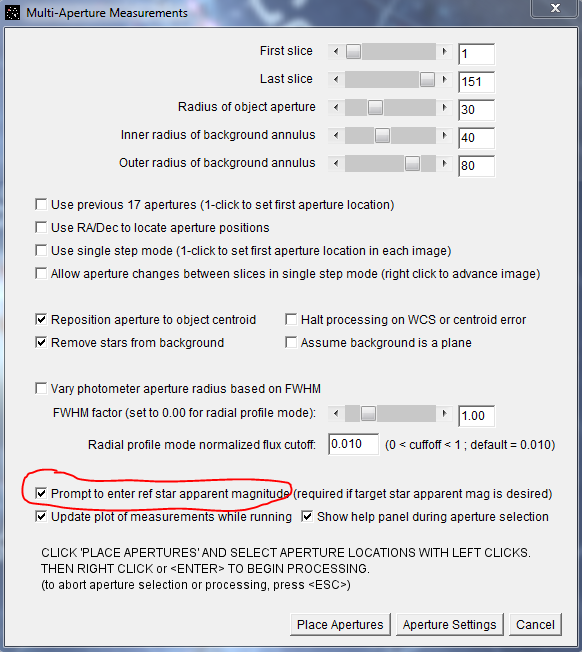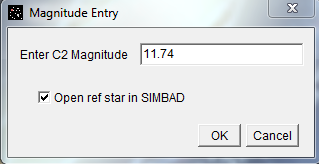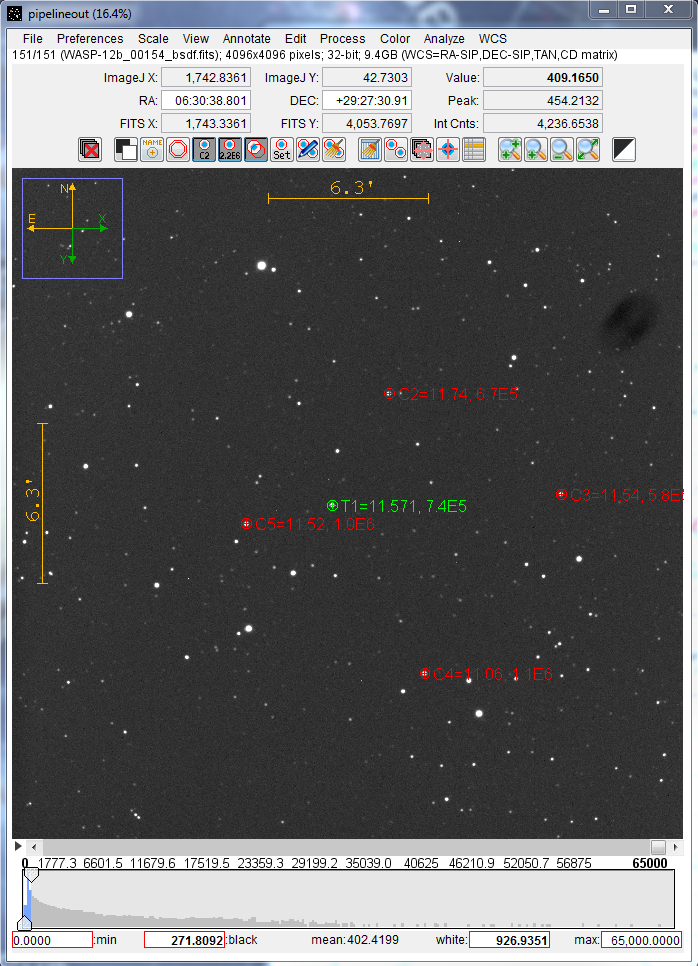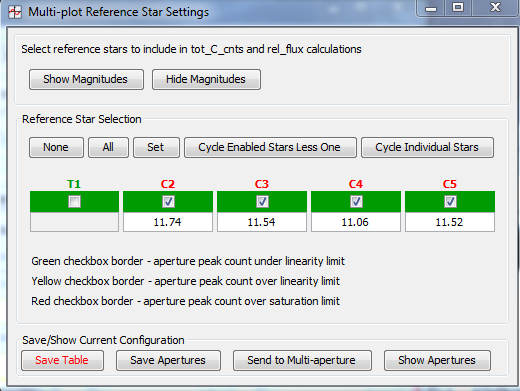Re: Enter apparent magnitude of reference stars to calculate magnitude of target stars (requires AIJ v3.1.0+)
Posted by karenacollins on Jan 27, 2015; 9:32am
URL: http://astroimagej.170.s1.nabble.com/Enter-apparent-magnitude-of-reference-stars-to-calculate-magnitude-of-target-stars-requires-AIJ-v3-1-tp236p237.html
First, make sure you know how to perform differential relative photometry on a times series of images by following chapter 10 of the latest AIJ user guide here:
http://www.astro.louisville.edu/software/astroimagej/guide/AstroImageJ_User_Guide.pdf
Following the same guidelines, load a stack of images into AIJ and start Multi-Aperture (MA) by clicking the MA icon ( ) above the
image display. The MA setup panel below will open. To be presented
with the option to enter ref star apparent magnitude, make sure
"Prompt to enter ref star apparent magnitude" is enabled as shown.
If the image stack has WCS headers (i.e. has been plate solved), by
default AIJ will also attempt to open the target(s) near the clicked
RA and Dec coordinates in SIMBAD, so that known magnitude data can
be easily collected.
) above the
image display. The MA setup panel below will open. To be presented
with the option to enter ref star apparent magnitude, make sure
"Prompt to enter ref star apparent magnitude" is enabled as shown.
If the image stack has WCS headers (i.e. has been plate solved), by
default AIJ will also attempt to open the target(s) near the clicked
RA and Dec coordinates in SIMBAD, so that known magnitude data can
be easily collected.

After setting up the other options above as needed in the MA setup panel, click "Place Apertures" and define target and comparison (reference) star apertures as usual. When a reference star is placed, the following dialog will open to allow the input of the reference star's magnitude. If it is left blank, that particular reference star will not be used to calculate the target star magnitude (however, the reference star will still be used to calculate target star relative flux and relative magnitude). If reference star magnitudes are already known, or it is preferred to search a different database for magnitudes, deselect the "Open ref star in SIMBAD" option.

After clicking OK, the ref star magnitude entered will show by default in the aperture image overlay as shown below. The first number is the entered magnitude and the second is total Source-Sky integrated counts. The display of those two numbers can be controlled by the two options near the bottom of the "View" menu above the image as well as the "value" display icon ( ) above the
image stack. The magnitude values for target stars are also
calculated 'on-the-fly' from the reference star magnitudes and
displayed as part of the target star's aperture image overlay. Each
time a new ref star magnitude is entered, the target star magnitudes
will be updated based on the combination of all reference star
magnitudes and integrated counts.
) above the
image stack. The magnitude values for target stars are also
calculated 'on-the-fly' from the reference star magnitudes and
displayed as part of the target star's aperture image overlay. Each
time a new ref star magnitude is entered, the target star magnitudes
will be updated based on the combination of all reference star
magnitudes and integrated counts.

Press <Enter> or right-click after all apertures have been defined to start processing the stack. Two new columns will be generated in the measurements table for each aperture that show magnitude (Source_AMag_Xxx) and magnitude error (Source_AMag_Err_Xxx) (where X= T or C, and xx is the aperture number). The ref star magnitudes will be constant in the measurements table, since those stars are assumed to be the constant magnitude as entered previously. Target star magnitudes are calculated for each image in the sequence based on the reference star magnitudes and target and reference star integrated counts from each image. The magnitude error is calculated based on the error calculated by AIJ for all of the apertures involved in computing the error, but does not include the error in the reference star standard magnitude that was entered from a database. The error in the standard reference star magnitudes should be added in quadrature to do the error reported by AIJ if the error results are to be reported in a scientific publication.
If Multi-Plot (MP) is opened by MA automatically, or if you start it later, the reference star magnitudes may be updated in the "Multi-plot Reference Star Settings" panel as shown below. If the reference star magnitude is changed (<Enter> must be pressed after entering a new magnitude value), or if a reference star is changed to a target star, all target star magnitudes are recalculated in the measurements table. The user may also wait to enter ref star magnitudes in MP (rather than in MA), if preferred. Right-click on the ref star magnitude box to open the object(s) at the aperture coordinates in SIMBAD. For the SIMBAD link to work in MP, the image stack is required to have been plate solved and the resulting measurements table columns RA_Xxx and Dec_Xxx must exist in the table. If the image stack had a plate solution and the RA and Dec columns are not in the table, check "Aperture Photometry Settings" "More" and make sure 'World Coordinates (RA,DEC)' is enabled and re-run MA.

The Source_AMag_Xxx column for the target star of interest is ideal for submitting to the Minor Planet Center using the new (as of v 3.1.0) MPC formatting option that is available under the Multi-plot Main->File menu.
URL: http://astroimagej.170.s1.nabble.com/Enter-apparent-magnitude-of-reference-stars-to-calculate-magnitude-of-target-stars-requires-AIJ-v3-1-tp236p237.html
First, make sure you know how to perform differential relative photometry on a times series of images by following chapter 10 of the latest AIJ user guide here:
http://www.astro.louisville.edu/software/astroimagej/guide/AstroImageJ_User_Guide.pdf
Following the same guidelines, load a stack of images into AIJ and start Multi-Aperture (MA) by clicking the MA icon (
 ) above the
image display. The MA setup panel below will open. To be presented
with the option to enter ref star apparent magnitude, make sure
"Prompt to enter ref star apparent magnitude" is enabled as shown.
If the image stack has WCS headers (i.e. has been plate solved), by
default AIJ will also attempt to open the target(s) near the clicked
RA and Dec coordinates in SIMBAD, so that known magnitude data can
be easily collected.
) above the
image display. The MA setup panel below will open. To be presented
with the option to enter ref star apparent magnitude, make sure
"Prompt to enter ref star apparent magnitude" is enabled as shown.
If the image stack has WCS headers (i.e. has been plate solved), by
default AIJ will also attempt to open the target(s) near the clicked
RA and Dec coordinates in SIMBAD, so that known magnitude data can
be easily collected.
After setting up the other options above as needed in the MA setup panel, click "Place Apertures" and define target and comparison (reference) star apertures as usual. When a reference star is placed, the following dialog will open to allow the input of the reference star's magnitude. If it is left blank, that particular reference star will not be used to calculate the target star magnitude (however, the reference star will still be used to calculate target star relative flux and relative magnitude). If reference star magnitudes are already known, or it is preferred to search a different database for magnitudes, deselect the "Open ref star in SIMBAD" option.

After clicking OK, the ref star magnitude entered will show by default in the aperture image overlay as shown below. The first number is the entered magnitude and the second is total Source-Sky integrated counts. The display of those two numbers can be controlled by the two options near the bottom of the "View" menu above the image as well as the "value" display icon (
 ) above the
image stack. The magnitude values for target stars are also
calculated 'on-the-fly' from the reference star magnitudes and
displayed as part of the target star's aperture image overlay. Each
time a new ref star magnitude is entered, the target star magnitudes
will be updated based on the combination of all reference star
magnitudes and integrated counts.
) above the
image stack. The magnitude values for target stars are also
calculated 'on-the-fly' from the reference star magnitudes and
displayed as part of the target star's aperture image overlay. Each
time a new ref star magnitude is entered, the target star magnitudes
will be updated based on the combination of all reference star
magnitudes and integrated counts.
Press <Enter> or right-click after all apertures have been defined to start processing the stack. Two new columns will be generated in the measurements table for each aperture that show magnitude (Source_AMag_Xxx) and magnitude error (Source_AMag_Err_Xxx) (where X= T or C, and xx is the aperture number). The ref star magnitudes will be constant in the measurements table, since those stars are assumed to be the constant magnitude as entered previously. Target star magnitudes are calculated for each image in the sequence based on the reference star magnitudes and target and reference star integrated counts from each image. The magnitude error is calculated based on the error calculated by AIJ for all of the apertures involved in computing the error, but does not include the error in the reference star standard magnitude that was entered from a database. The error in the standard reference star magnitudes should be added in quadrature to do the error reported by AIJ if the error results are to be reported in a scientific publication.
If Multi-Plot (MP) is opened by MA automatically, or if you start it later, the reference star magnitudes may be updated in the "Multi-plot Reference Star Settings" panel as shown below. If the reference star magnitude is changed (<Enter> must be pressed after entering a new magnitude value), or if a reference star is changed to a target star, all target star magnitudes are recalculated in the measurements table. The user may also wait to enter ref star magnitudes in MP (rather than in MA), if preferred. Right-click on the ref star magnitude box to open the object(s) at the aperture coordinates in SIMBAD. For the SIMBAD link to work in MP, the image stack is required to have been plate solved and the resulting measurements table columns RA_Xxx and Dec_Xxx must exist in the table. If the image stack had a plate solution and the RA and Dec columns are not in the table, check "Aperture Photometry Settings" "More" and make sure 'World Coordinates (RA,DEC)' is enabled and re-run MA.

The Source_AMag_Xxx column for the target star of interest is ideal for submitting to the Minor Planet Center using the new (as of v 3.1.0) MPC formatting option that is available under the Multi-plot Main->File menu.
| Free forum by Nabble | Edit this page |